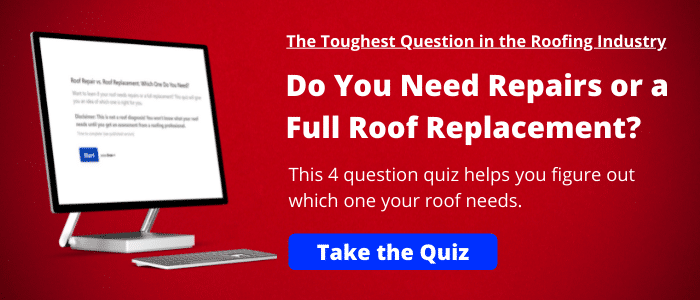Why Does My Roof Only Leak Sometimes?
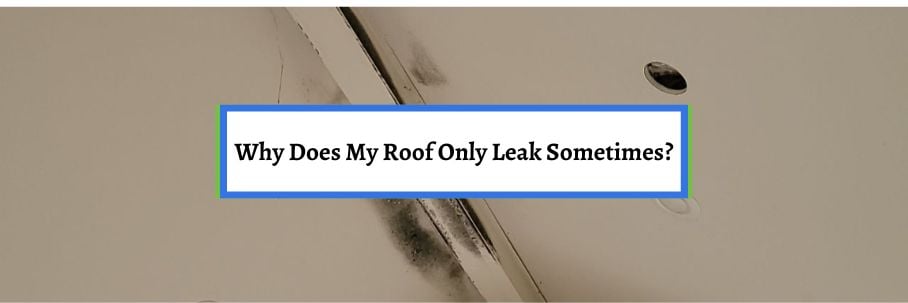
Finding signs of a roof leak isn’t a fun experience. What makes it even more frustrating is that it only seems to happen every now and again.
Is it even possible to have a roof that leaks occasionally? After all, a roof leak normally indicates a problem that must be solved before the water stops coming into your home.
So, I understand how confusing it is that your roof isn’t leaking every time it rains. The last thing I want is for you to be confused about this pressing issue.
For over 30 years, the team at Bill Ragan Roofing has helped homeowners understand their roof problems so they know the appropriate next steps. Because of this, I’ll break down why your roof leaks occasionally.
In this article, you’ll learn:
- Why does my roof only leak sometimes?
- The 6 mains why your roof could be leaking
Why does my roof only leak sometimes?
When a roof only leaks sometimes, it’s usually during heavy rain and severe weather. When hard and horizontal rain hits your roof during storms, it sends water places it wouldn't normally go.
This leads to water getting into or behind areas that aren’t meant to shed water. There’s also the fact that you’ll have a lot more water running down your roof.
This excess water catches a small problem (like a sticking up nail) and pulls the water into your home. Just know that this means you already or will have a leak, but it’s only noticeable when a lot more water saturates the area.
Even if your roof only leaks sometimes, I still recommend contacting your local roofer for an inspection to ensure there’s no immediate problems.
The 6 mains reasons why your roof could be leaking
Now you know why your roof only leaks sometimes. But while you know the cause is from heavy or prolonged rain storms, I didn’t cover what’s actually leaking.
That’s why the rest of this article breaks down the 6 main reasons why your roof is leaking during heavy rain or even lighter storms.
1. Chimney saturation causing leaks
Anytime there’s heavy rain or a prolonged period of rain, it’s guaranteed we’ll get calls about chimney leaks. The leak could be from problems with the integrity of the metal roof flashing surrounding the chimney.
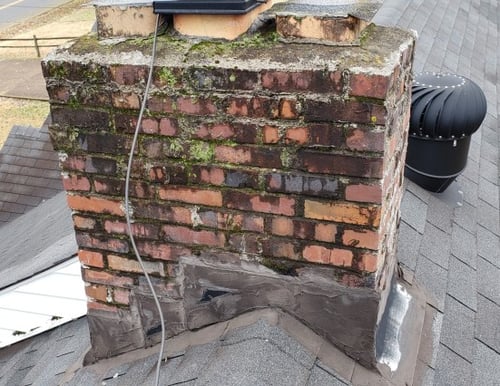 (Oversaturated brick chimney)
(Oversaturated brick chimney)
If you have a brick chimney, it could be due to the mortar joints becoming so saturated from prolonged periods of rain that water starts coming into the interior of your home. It can also be as simple as water coming through the top of the chimney.
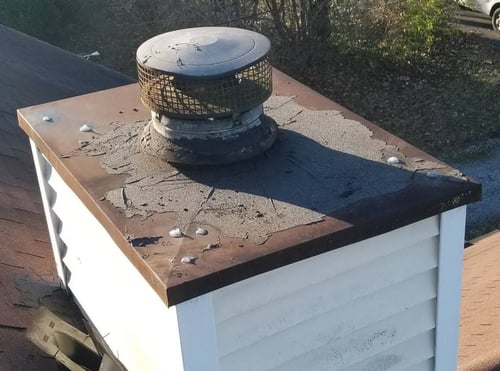
Just know that a roofing contractor can take care of chimney problems that have to do with the roof specifically. However, you’ll need to hire a chimney company for problems with a chase top and/or spark arrestor.
2. Leaks caused by problems with your roof flashing
Just like compromised chimney flashing, problems with roof flashing in other roof areas are the next reason a roof leaks. The obvious signs of compromised flashing are cracks or holes caused by the metal rusting.
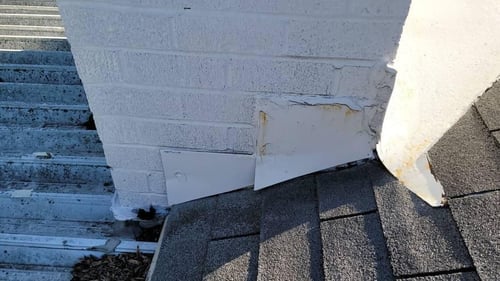 (Rusted roof flashing)
(Rusted roof flashing)
While this is common, there are also leaks caused by improperly installed roof flashing. In the worst-case scenario, there are even roofs where the flashing is left off completely.
Unfortunately, these situations require costly repairs or a complete flashing replacement job.
3. Leaks around roof penetrations
The next cause of a roof leak (and most common roof leak in general) is when a plumbing vent’s pipe boot or another penetration’s flashing fails. A pipe boot goes around the base of roof pipes to ensure water doesn’t follow the penetration into your home.
The most common type of pipe boot used today is made of a synthetic rubber called neoprene. Prolonged exposure to UV from the sun breaks down the neoprene, and the boot eventually develops cracks.
.jpg?width=461&height=500&name=CrackedPipeBoot%20(2).jpg)
Once it cracks or pieces break off, water runs down the pipe into the room below it (closet, kitchen, bathroom, etc.). While leaks around pipes are common, leaks around skylights are also common.
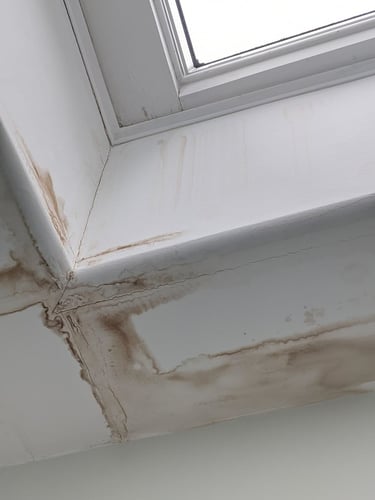 (Leak around skylight)
(Leak around skylight)
This could be from a problem with one of the skylight’s components, or the seal is worn down to the point that it’s time for a replacement. However, the main cause of skylight leaks is improper skylight installation.
4. Wet debris sitting on your roof
Neglecting roof maintenance allows debris to build up on your roof and in your roof valleys. When this happens, it builds a literal dam of leaves and sticks on your roof.
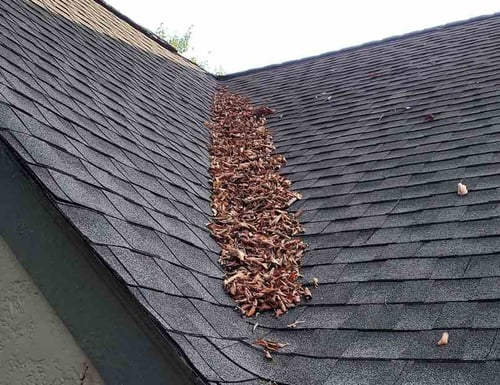
This debris dam stops water from flowing down properly and causes pooling water to back up the roof. This allows the sitting water to find the path of least resistance and could even get underneath your shingles.
Luckily, reputable roofing contractors install materials in roof valleys to prevent leaks. However, wet and saturated debris left to sit year after year will eventually damage your shingles.
That’s why getting an annual roofing maintenance inspection is important to clear your roof and gutters of any debris.
5. Nails backing out through your shingles
After pipe boot failure, the most common type of roof leak I see is from popped-up or improperly driven roofing nails. When a roofing nail isn’t driven in far enough or is driven in sideways, the head of the nail works its way up through the shingle.
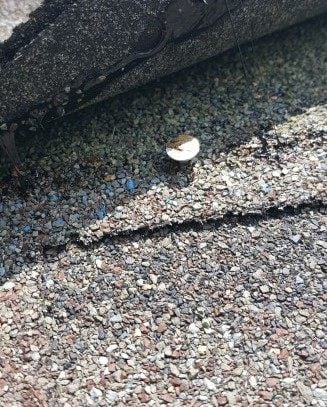
This lets water catch the lifted nail as it comes down your roof and follows the nail inside your home. This not only happens to shingle nails, but I also see it happen with decking nails.
No matter the installation method, the nails must hit good wood to hold tight and snug to avoid potential problems.
6. Your roof has reached the end of its lifespan
The last reason why your roof could be leaking is simply that it reached the end of its lifespan. Every type of roof has a specific lifespan range determined by how long the materials and components are meant to last.
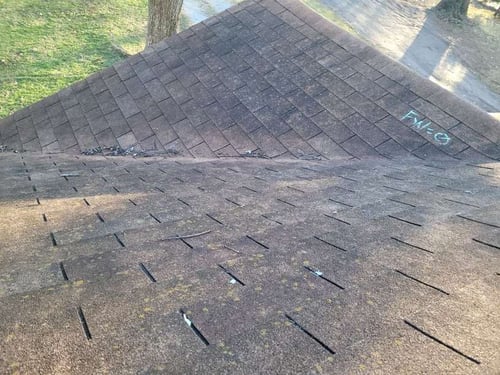 (Old 3-tab asphalt shingle roof that needs replaced)
(Old 3-tab asphalt shingle roof that needs replaced)
For example, an architectural asphalt shingle roof should last around 22-25 years. So, it’s not uncommon to see leaks once you get around that 22-25 year mark.
However, it ultimately comes down to the quality of materials you invested in and your roofing contractor’s workmanship. But if you have an older roof leaking, it’s most likely trying to tell you it’s time for a replacement.
How do you find the source of a roof leak?
Now you know why your roof only leaks sometimes and the main reasons why your roof is leaking. After reading this article, you’re ready to determine if you should call a roofing contractor for an inspection.
I always recommend hiring a professional, but I understand that some homeowners want to try to find the problem themselves. Maybe it’s because they want to pass on as much information as possible to the roofer, or maybe they want to do a DIY repair.
No matter which one you do, you need to know how to track a roof leak. You’re probably thinking, “I know where the water is coming in, so obviously, I’ll be able to find the problem.”
Unfortunately, it’s not that simple. That’s why I wrote another article breaking down the steps to find a roof leak.
Check out How to Find a Roof Leak to learn how to track your roof leak right to the source.


